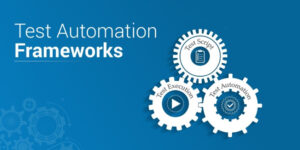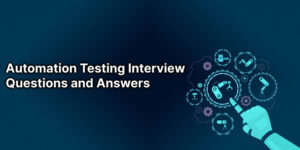
Step into a world where human ingenuity intertwines with technological prowess—the captivating realm of the Selenium Framework. Here, the mundane is transformed into magic, and the burdensome becomes effortless. Picture a landscape where your time is liberated, creativity flourishes, and where the power of automation serves as your trusted ally.
Seamlessly integrating into your workflows, this framework becomes your invaluable companion, supporting you in navigating the intricacies of web application testing. Each click and script empowers you to focus on what truly matters—fostering innovation, driving progress, and, ultimately, unlocking the extraordinary potential within you. Welcome to the future of automation, woven with a touch of humanity.
What is the Selenium Framework?
The Selenium Framework is like a skillful conductor orchestrating a symphony of automation. It empowers testers and developers to create robust and reliable web application tests easily. Imagine having a digital assistant by your side, seamlessly navigating through web pages, interacting with elements, and validating functionality—all while you sip your favorite cup of coffee.
This framework embraces the spirit of collaboration, enabling teams to harmonize their efforts and achieve exceptional results. It transcends the boundaries of repetitive tasks, allowing you to focus on the artistry of testing, shaping the future of software quality with every line of code—Selenium Framework, where human ingenuity meets the limitless possibilities of automation.
Types of Framework in Selenium
1. Linear Scripting Framework
Accelerate your testing process with the Linear Scripting Framework, simplifying test execution through linear and record-and-playback methods.
Features:
- Record and playback functionality for test script creation.
- Linear execution of test scripts.
- Suitable for small-sized applications.
- Testers record each test step, including browsing, navigation, user inputs, and checkpoints.
Pros:
- Quick generation of test scripts without extensive preparation.
- No coding skills are required, making it accessible to non-technical users.
- Easy and fast generation of test scripts.
- Saves time in test script preparation.
- Ideal for testers with limited programming knowledge.
- Provides a simple method for quickly generating test scripts.
Cons:
- Lack of reusability due to auto-generated scripts.
- Inability to execute with multiple data sets as data is hardcoded.
- High maintenance cost for even minor changes.
Please note that the Linear Framework is just one approach to Selenium automation, and other frameworks offer different benefits and capabilities. Selecting a framework that fits your project’s needs and the team’s expertise is essential.
2. Modular Testing Framework
The Modular Testing Framework is a methodology where testers develop separate test scripts for each module of an application under test. These modules can then be combined using a master script to create end-to-end test scenarios.
Features:
- Testers create separate modules for different functionalities of the application.
- Each module has its own test script.
- A master script is used to combine modules and execute end-to-end test scenarios.
Pros:
- Enhanced scalability and ease of maintenance as the application is split into more diminutive modules.
- Test scripts can be developed independently for each module, allowing for better organization and reusability.
- Changes made in one module have minimal impact on other modules, ensuring stability and easier maintenance.
Cons:
- Requires additional time to analyze and identify reusable processes for each module.
- Limited support for multiple data sets as test scripts may contain hardcoded data.
- Setting up the framework may require coding skills.
Please note that the Modular Testing Framework offers flexibility and reusability, allowing testers to create independent test scripts for different application modules. However, identifying reusable processes and setting up the framework requires some initial effort.
Remember, choosing the proper framework depends on your project’s specific needs and requirements and the skills and resources available within your team.
Also See: How to Implement a Functioning Test Automation Program
3. Library Architecture Testing Framework
Also known as “Structured Scripting” or “Functional Decomposition,” this framework is used to test the architecture of libraries. It has some additional advantages due to its modular design.
Features:
- Identification and grouping of common tasks into functions.
- Creation of a reusable functions library.
- Test scripts utilize the functions library for generating new tests.
Pros:
- Ease of script maintenance.
- Scalability and adaptability.
- Reusability of the functions library.
Cons:
- Requirement of coding skills for implementation
- Increased time required for designing test scripts
- Test scripts contain hardcoded test data, limiting flexibility
Please note that the Library Architecture Testing Framework offers benefits such as maintainability, scalability, and reusability through its functions library. However, it requires coding expertise, and test script design may take longer due to the inclusion of hardcoded test data.
4. Data-Driven Framework
The Data-driven Framework in test automation is designed to separate the test script logic from the test data, allowing for the generation of automated test scripts with different data sets. It provides flexibility by enabling testers to input multiple test data sets, enhancing the efficiency of test automation.
Test data sets are stored in external files or resources such as Excel sheets, Access tables, SQL databases, or XML files. The test scripts establish associations with these resources to retrieve the test data. This framework allows for the efficient execution of test scripts with various test data sets, reducing the number of test scripts required compared to other frameworks.
Features:
- Separation of test script logic from test data.
- External storage of test data in files or resources.
- Efficient execution of test scripts with various test data sets.
Pros:
- Compatibility with various data sets.
- Test script changes have no impact on the test data.
- No need to hardcode test data.
- Time-saving by running a more significant number of tests.
Cons:
- Requires coding skills to implement and utilize the framework.
- The structure of the framework and test data may require additional time.
- Framework design may require expertise from professional automation testers.
Please note that the Data-driven Framework offers flexibility and scalability by allowing test scripts to be executed with different data sets. However, it does require testers with programming experience to build the test scripts and implement the framework.
When selecting a framework, consider your project’s specific requirements and your team members’ expertise.
5. Keyword Driven Testing Framework
The Keyword Driven Testing Framework, or table-driven or action word-based testing, is a powerful approach that leverages keywords to guide the testing process. It employs a structured table format to define specific keywords or action words associated with each function or method to be tested.
This framework provides a clear and concise way to orchestrate test cases, making it easier to manage and execute tests efficiently. By utilizing this methodology, testers can streamline the testing process and achieve comprehensive test coverage while ensuring optimal test case reusability. Automation test scripts are then executed based on the keywords provided in an Excel sheet or similar formats, and the results are reported.
Features:
- Use of keywords or action words to drive the testing process.
- Table network to define keywords for each process.
- Execution of automation test scripts based on keywords from an external source.
Pros:
- Permits testers with limited programming expertise to use keywords to operate on test automation scripts.
- Code reusability by directing multiple scripts to the same keyword using variables.
- Test scripts remain unchanged even if the application changes.
- Ability to make tests before the application is developed.
- Test scripts can be used independently of the application with minor modifications.
- Not dependent on specific test tools.
Cons:
- Designing the framework may require more time and initial investment.
- Requires testers with solid test automation skills to implement and maintain the framework.
Please note that the Keyword Driven Testing Framework offers a user-friendly approach for testers without extensive programming knowledge to create test automation scripts using keywords. However, it may require initial setup and the expertise of testers with solid test automation skills.
When choosing a framework, consider your project’s specific needs, your team members’ expertise, and the framework’s suitability for your testing requirements.
RELATED: Top 20+ Cross Browser Testing Tools to Use
What is a Hybrid Framework in Selenium?
In the dynamic world of test automation, the Hybrid Driven Testing Framework emerges as a versatile and adaptable solution, harnessing the best of various frameworks. Like a master chef blending different flavors to create a delectable dish, this framework combines the strengths and advantages of other frameworks tailored to specific test environments.
It is the go-to choice for many teams in today’s market, striving to achieve optimal efficiency and effectiveness. With its flexible nature and ability to cater to diverse needs, the Hybrid Driven Testing Framework is a testament to the ingenuity and creativity of testing professionals, shaping the future of automation, one test case at a time.
What is a Behavior-Driven Development Testing Framework in Serinium?
Welcome to Behavior Driven Development (BDD) Testing Framework, where collaboration and effective communication take center stage. This framework strives to create a platform where diverse stakeholders, including Business Analysts, Developers, and Testers, can actively participate in the testing process. Filling the void between development and testing teams emphasizes open dialogue and fosters a shared understanding of project requirements.
The beauty of BDD lies in its ability to transcend programming language barriers, enabling users to express test requirements using non-technical, everyday language. With powerful tools like JBehave and Cucumber, the possibilities for efficient and user-centric testing are endless. Prepare to embark on a journey where teamwork and clear communication pave the way to success.
In conclusion, the Selenium Framework revolutionizes how we approach software testing, blending human ingenuity with the power of automation. It empowers testers and developers to streamline workflows, automate repetitive tasks, and confidently deliver high-quality applications. From the modular and data-driven frameworks to the keyword-driven and hybrid approaches, Selenium offers a versatile toolkit that caters to diverse testing needs.
With each test script and automated interaction, we embark on a journey of continuous improvement, unlocking new possibilities and pushing the boundaries of innovation. Embracing Selenium, we welcome the future of testing, where humans and tools cooperate to make exceptional software experiences.






